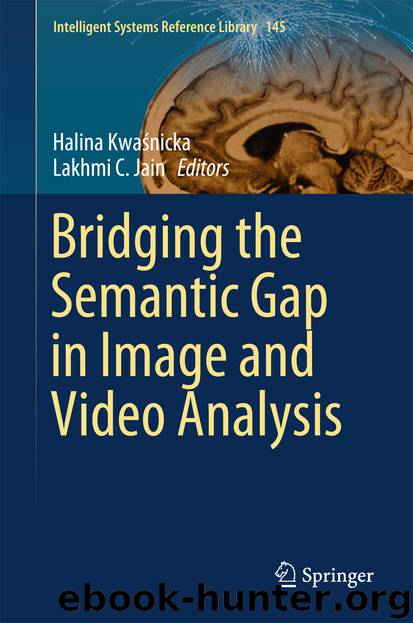Bridging the Semantic Gap in Image and Video Analysis by Halina Kwaśnicka & Lakhmi C. Jain

Author:Halina Kwaśnicka & Lakhmi C. Jain
Language: eng
Format: epub
Publisher: Springer International Publishing, Cham
5.6 Testing Scenarios
As an simple illustration, generic mug model will be used (similar to presented in previous sections), with two distinct modalities of incoming data: RGB image and RGB-D image. In first scenario, edge-based analysis [37] is applied, with two basic concepts—Cylinder and Arc, corresponding to two mug parts—body and handle. Second scenario uses depth data [38], and two basic surface concepts—Cylinder and Thorus.
5.6.1 Data Acquisition
As an input data, Complex scene 3 from WUT Visual Perception Dataset [39] was used, which contains a recorded trajectory (77 points) “around the table”. The set was acquired using Microsoft Kinect sensor, and it contains, for every recorded position, a pair of images, aligned with each other: RGB image (Fig. 5.9a) and depth map (Fig. 5.9b). The selected scene contains three cylindrical objects—two mugs and one coffee jar, as well as some other kitchen utensils.
The data was acquired with hand-held sensor, thus there is no ground-truth position data and the trajectory was recovered using visual odometry solution [5].
Fig. 5.9Test scene: a RGB image, b depth map
Download
This site does not store any files on its server. We only index and link to content provided by other sites. Please contact the content providers to delete copyright contents if any and email us, we'll remove relevant links or contents immediately.
Algorithms of the Intelligent Web by Haralambos Marmanis;Dmitry Babenko(9832)
Test-Driven Development with Java by Alan Mellor(7661)
Data Augmentation with Python by Duc Haba(7544)
Principles of Data Fabric by Sonia Mezzetta(7320)
Learn Blender Simulations the Right Way by Stephen Pearson(7236)
Microservices with Spring Boot 3 and Spring Cloud by Magnus Larsson(7071)
RPA Solution Architect's Handbook by Sachin Sahgal(6461)
Jquery UI in Action : Master the concepts Of Jquery UI: A Step By Step Approach by ANMOL GOYAL(6447)
The Infinite Retina by Robert Scoble Irena Cronin(6171)
Hadoop in Practice by Alex Holmes(6138)
Big Data Analysis with Python by Ivan Marin(5886)
Life 3.0: Being Human in the Age of Artificial Intelligence by Tegmark Max(5474)
Pretrain Vision and Large Language Models in Python by Emily Webber(4843)
Infrastructure as Code for Beginners by Russ McKendrick(4625)
WordPress Plugin Development Cookbook by Yannick Lefebvre(4343)
Functional Programming in JavaScript by Mantyla Dan(4216)
The Age of Surveillance Capitalism by Shoshana Zuboff(4210)
Embracing Microservices Design by Ovais Mehboob Ahmed Khan Nabil Siddiqui and Timothy Oleson(4114)
Applied Machine Learning for Healthcare and Life Sciences Using AWS by Ujjwal Ratan(4094)
